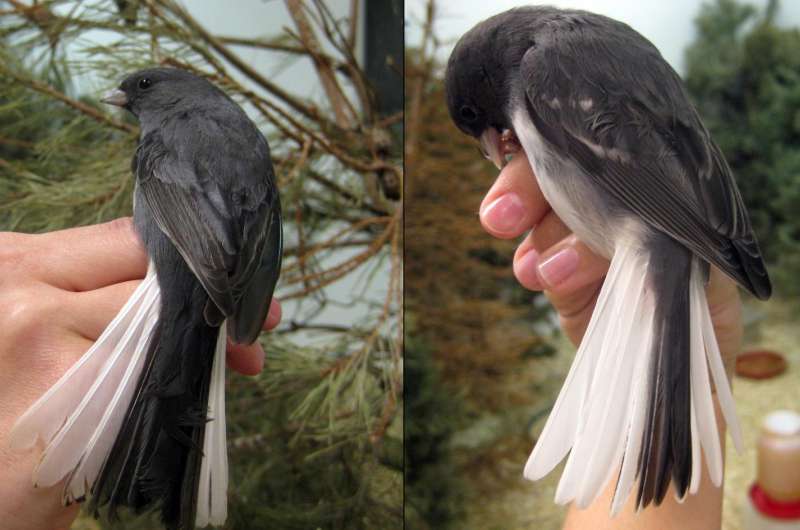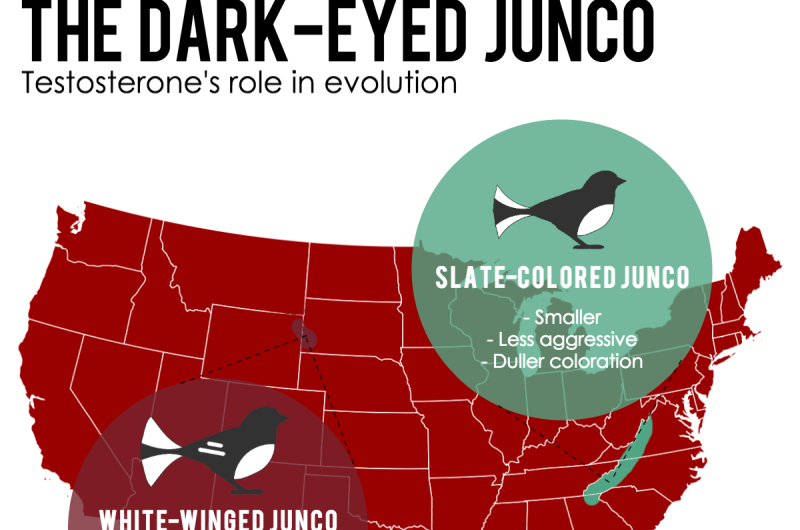When it comes to evolution, testes may play a key role, studies find

A pair of studies led by Indiana University researchers provide new evidence that when it comes to evolution, the testes may play a key role.
The research, led by Kimberly Rosvall, assistant professor in the IU College of Arts and Sciences' Department of Biology, finds that the testes—or gonads—have a greater impact than previously thought in evolution. The research was conducted in two subspecies of dark-eyed junco, a type of American sparrow.
The white-winged junco, or Junco hyemalis aikeni, is found in the Black Hills of South Dakota. The slate-colored junco, or Junco hyemalis carolinensis, is from the Appalachian Mountains in Virginia. The first is larger and more aggressive; the other is smaller and more docile.
The studies are published in the journals of Hormones and Behavior and of Integrative and Comparative Biology.
The first paper compares the subspecies in their expression of enzymes that make testosterone within the gonad. The second paper investigates how the subspecies' gonads differ in the expression of stress hormone receptor genes, which are known to lower testosterone.
"The majority of endocrinologists will tell you that testosterone-mediated traits such as physical appearance or behavior are regulated in a top-down fashion—that the brain acts as the 'CEO,' telling the rest of the body what to do," Rosvall said. "But our data suggest that this CEO model is oversimplified, and that the workers in the testosterone 'factory'—the gonad—may actually play an important role in trait divergence."
Compared to the Virginia juncos, the South Dakota birds are not only larger and more aggressive, they also boast flashier plumage, including more white tail feathers and prominent white bars on their wings. All these traits are influenced by testosterone, which is widely recognized in biology to influence traits important in natural selection, such as survival and reproduction.
Within a population, some males produce more testosterone, others produce less. Over evolutionary time, average levels of testosterone—and the traits that testosterone regulates, such as aggression, body size, and even parental care or sex drive—may evolve to suit a given environment. The genomic mechanisms that allow testosterone levels to evolve, however, are not well understood.

To conduct their research on the topic, Rosvall and colleagues studied the gonads of the two subspecies in the wild and in captivity. In the case of the South Dakota juncos, the results suggested the brawnier birds' gonads simply had more abundant testosterone-producing machinery. When the researchers treated the birds with a testosterone-stimulating hormone, the South Dakota birds were able to make more testosterone faster and keep it elevated longer.
"An animal that keeps testosterone elevated for longer should have greater expression of these testosterone-mediated characteristics," Rosvall said.
In the second study, Rosvall and colleagues found an additional cause for lower testosterone levels in the Virginia juncos. The smaller birds' testes expressed higher levels of stress hormone receptors—known inhibitors of the production of testosterone.
The mechanism by which testosterone results in different traits involves hormone receptors found in the brain and body. When testosterone binds to these sites, it affects the expression of genes that influence characteristics such as behavior, body size and plumage.
"At the genomic level, you can really see a significant difference between these big, sexy juncos and their smaller, less aggressive cousins," Rosvall said. "Because we still saw some of these differences in males that we captured as juveniles, our research suggests that these differences in the gonad are genetic, or programmed very early in life."
The results are significant because they challenge the prevailing theory that hormonally regulated trait differences between species are controlled largely by the brain. In earlier studies, the IU team looked at various aspects of the brain and the pituitary, a gland that acts as an intermediary between the brain and the gonad, with results that suggested some difference between the gonads in high- versus low-testosterone males.
"These studies identify those differences," Rosvall said. "It has real implications for the growing fields of evolutionary endocrinology and ecological genomics.
"Whether it's birds or mice or people, testosterone influences a lot of traits in nature—traits that impact who lives or dies, who mates or doesn't," she added. "Our research suggests that the gonad itself is an important player in the evolutionary process."
More information: Kimberly A. Rosvall et al, Divergence along the gonadal steroidogenic pathway: Implications for hormone-mediated phenotypic evolution, Hormones and Behavior (2016). DOI: 10.1016/j.yhbeh.2016.05.015
Kimberly A. Rosvall et al. Gonads and the evolution of hormonal phenotypes, Integrative and Comparative Biology (2016). DOI: 10.1093/icb/icw050
Journal information: Hormones and Behavior
Provided by Indiana University



















